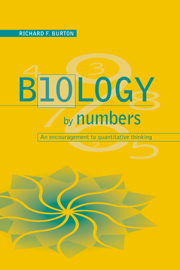Book contents
- Frontmatter
- Contents
- Preface
- A guide to the book
- 1 Putting two and two together
- 2 Units, formulae and the use of old envelopes: confronting some obstacles to quantitative thinking
- 3 Aspects of energy metabolism
- 4 Getting things in proportion
- 5 Perilous percentages, dangerous ratios
- 6 Building a trophic pyramid
- 7 Sodium in animals and plants
- 8 Exchanges of water and carbon dioxide
- 9 A geometric series
- 10 Introduction to logarithms
- 11 Bringing logarithms to life
- 12 Exponential relationships
- 13 Aspects of allometry
- 14 More on allometry, and on quantitative patterns in nature
- 15 How the abundance of food affects rates of feeding
- 16 The characterization of trees and other branching systems
- 17 Epilogue
- References
- Notes
- Index
1 - Putting two and two together
Published online by Cambridge University Press: 05 June 2012
- Frontmatter
- Contents
- Preface
- A guide to the book
- 1 Putting two and two together
- 2 Units, formulae and the use of old envelopes: confronting some obstacles to quantitative thinking
- 3 Aspects of energy metabolism
- 4 Getting things in proportion
- 5 Perilous percentages, dangerous ratios
- 6 Building a trophic pyramid
- 7 Sodium in animals and plants
- 8 Exchanges of water and carbon dioxide
- 9 A geometric series
- 10 Introduction to logarithms
- 11 Bringing logarithms to life
- 12 Exponential relationships
- 13 Aspects of allometry
- 14 More on allometry, and on quantitative patterns in nature
- 15 How the abundance of food affects rates of feeding
- 16 The characterization of trees and other branching systems
- 17 Epilogue
- References
- Notes
- Index
Summary
Multiplication is vexation.
Division is as bad.
The rule of three doth puzzle me,
And Practice drives me mad.
Manuscript, 1570.And yet a little arithmetic can sometimes yield important insights into biology and do so even when the starting data and final numerical answer are quite inexact. In this chapter I illustrate this with several unrelated examples, and in doing so try to make some general points about simple biological arithmetic. As for biological content, the topics touched on are the importance of earthworms, estimating the number of beetle species in the world, the extinction of Hawaiian birds, pollen and bees, whales and giant redwoods, photosynthesis, the numbers and sizes of cells in the human body, the circulation of the blood, human kidney function and, finally, bats and their insect prey. Partly for their historical interest, I have chosen some of my examples from long ago, these being provided by Charles Darwin, Edmond Becquerel, William Harvey and Rudolph Heidenhain, but others are much more recent.
Darwin's earthworms
Biology owes so much to Charles Darwin that I am happy to choose my first example from his book The Formation of Vegetable Mould, through the Action of Worms, with Observations on their Habits (1881). Although every gardener must be aware now how vital earthworms are for the soil, it must be easy for other people to view these animals with disdain, if they give them any thought at all.
- Type
- Chapter
- Information
- Biology by NumbersAn Encouragement to Quantitative Thinking, pp. 1 - 22Publisher: Cambridge University PressPrint publication year: 1998



